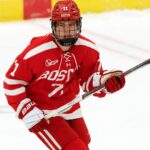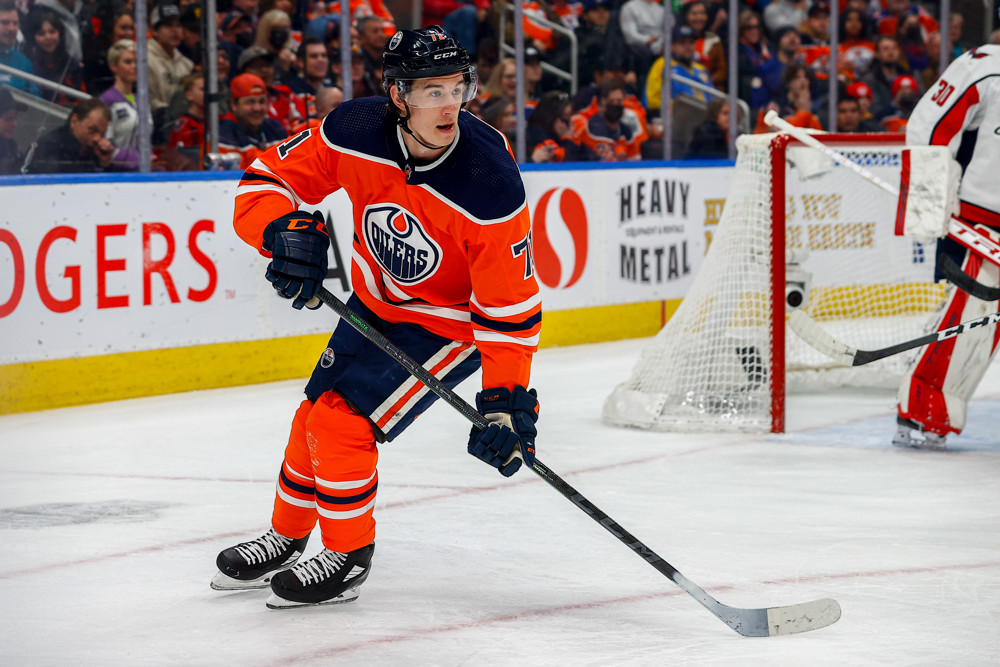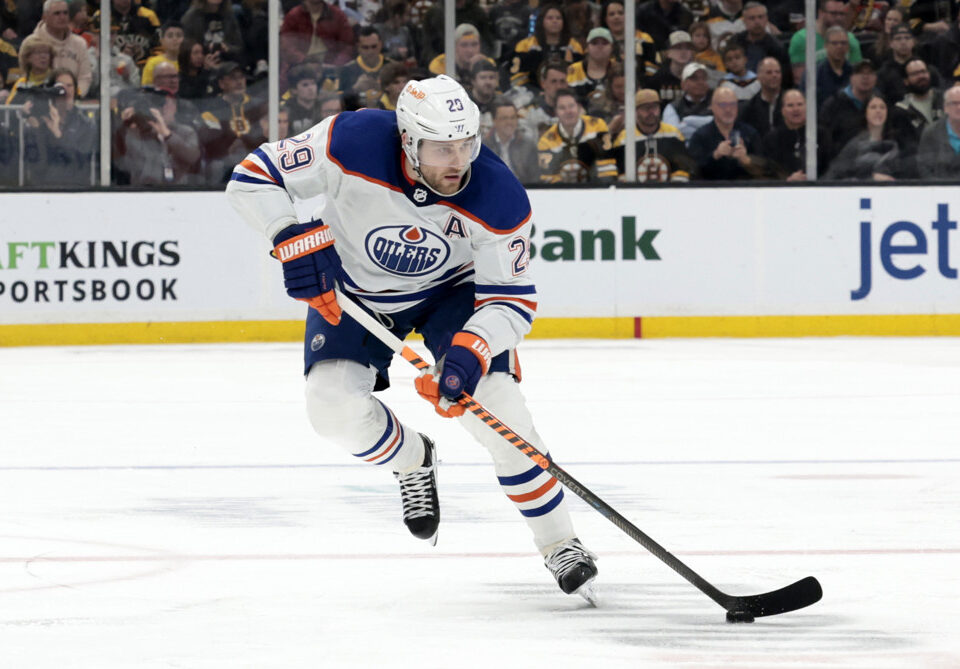
2024 NHL Draft Outlook
May 26, 2024
Call Outs, Stand Outs, and Shoutouts: Stars retake home ice advantage with Game 3 win
May 28, 2024Is McLeod’s defensive play compensating for his lack of offence?

EDMONTON, AB - MARCH 9: Edmonton Oilers Winger Ryan McLeod (71) in action in the first period during the Edmonton Oilers game versus the Washington Capitals on March 9, 2022 at Rogers Place in Edmonton, AB. (Photo by Curtis Comeau/Icon Sportswire)
May 26, 2024 by Ryan Lotsberg
Edmonton Oilers fans remember that the line of Jack Eichel, Jonathan Marchessault, and Ivan Barbashev gave the Oilers fits in their second round series with the Vegas Golden Knights last year. Woodguy wrote an excellent breakdown last summer suggesting that then head coach Jay Woodcroft could have utilized his centres better to get a different result against the Eichel line.
The argument was that Ryan McLeod should have been utilized more against Eichel in that series because McLeod’s performance against elite competition was superior to Leon Draisaitl’s in the regular season and in the playoffs. Draisaitl was on the ice for three goals against Eichel in Games 5 and 6 of that series (even though Draisaitl’s xGF% vs Eichel in Game 5 was 87.3%). If McLeod had seen more ice time against Eichel, then the Oilers might have allowed fewer goals and increased their odds of winning the series.
Fast forward to the 2024 playoffs. McLeod has become something of a polarizing player among Oilers fans. He has yet to record a point in fourteen playoff games this spring, but a lot of people are defending his defensive play. Let’s dive into the numbers and see what all the hubbub is about.
The Numbers
| CF% | SF% | SCF% | HDCF% | xG% | GF% | |
| McLeod 23-24 (14 GP) | 49.83% (148-149) | 56.82% (75-57) | 45.93% (62-73) | 51.85% (28-26) | 55.35% | 14.29% (1-6) |
| McLeod 22-23 (12 GP) | 61.16% (148-94) | 60.32% (76-50) | 62.5% (75-45) | 69.81% (37-16) | 62.86% | 44.4% (4-5) |
Let’s look at McLeod’s 2023-24 numbers first. In case you’re not familiar with the terminology, Corsi for percentage (CF%) is a measure of all blocked and unblocked shot attempts for and against while a player is on the ice. Shots for percentage (SF%) measures the shots on goal for and against while a player is on the ice.
McLeod’s CF% is much lower than his SF%. McLeod’s CF% has only been at 50% or higher in five of the Oilers’ fourteen playoff games so far this spring, which tells us that teams are attempting more shots at the Oilers goal than the Oilers are attempting at the opponent’s goal with McLeod on the ice. That tells me that McLeod has been spending more time in his own zone than in the offensive zone.
However, McLeod has only had a SF% below 50% in three games. His SF% has not been below 50% since Game 2 of the second round. That tells me that while teams are spending more time in the Oilers zone when McLeod is on the ice, their shot attempts have mostly come from the outside. Teams will get shot attempts, but if those attempts don’t hit the net often then I see that as a sign of good defending because NHL players don’t miss the net on dangerous chances often.
McLeod’s high danger scoring chances for percentage (HDCF%) supports my theory. He is on the ice for more high danger scoring chances for than against (albeit by a small margin). However, his scoring chances for percentage is really low. The difference between a scoring chance and a high danger scoring chance is the location of the shot attempt. Shot attempts on high danger scoring chances are taken from the middle of the slot area. McLeod appears to be defending that area well; but he is on the wrong side of the scoring chance battle. That is a sign of poor overall defending.
There are a lot of factors that go into goal share, but it is the only number that ultimately matters. McLeod has been outscored 1-6 at five-on-five in these playoffs. That’s not good enough.

McLeod had five assists in twelve games last year, and he has zero points in fourteen games this year. Are McLeod’s numbers the result of him not defending well enough, or is this an offensive issue? Let’s compare his numbers this year to his numbers from last year.
McLeod was FAR better last year in every single metric I’ve outlined in this piece. The biggest concerns lie in his scoring chance metrics. McLeod has been on the ice for 28 more scoring chances against this year than last year in just two more games played, and he has been on the ice for ten more high danger scoring chances this year than last year. Conversely, McLeod has been on the ice for thirteen fewer scoring chances and nine fewer high danger scoring chances for this year than last year.
Those numbers tell the story. McLeod has been much less effective at both ends of the ice in these playoffs than he was in last year’s playoffs.
Wrap
It’s clear that McLeod’s point production is down from last spring, but his scoring chance production is also lower in these playoffs.
There is not enough evidence in the numbers to suggest that McLeod is playing well enough defensively to compensate for the lack of offence. He is allowing shot attempts at a significantly higher rate this season than last season, and he is allowing scoring chances at a much higher rate. McLeod has been on the ice for six five-on-five goals against in these playoffs, including one in each of the last four games.
McLeod’s expected goals percentage of 62.86% last year was fantastic. That number has dipped to 55.35% in these playoffs, which is worse but still pretty good. His PDO (which combines save percentage and shooting percentage) is only at .908 (awful) this year compared to .953 (below average) last year.
The good news is that both his xG% and his low PDO suggest that McLeod’s goal share should improve over time. The tides need to start turning ASAP because the Oilers can’t afford to have their third line center losing the goal share in such lopsided fashion. I believe in McLeod, but he needs to be better.
Adam Henrique is close to returning to the lineup. Head coach Kris Knoblauch said that Henrique was at 98% before Game 2, which implies that he could be at or close to 100% for Game 3. That means that Knoblauch has a decision to make.
Related: Connor McDavid scores the game-winner as Oilers prevail in double overtime
Some people have suggested that McLeod should be scratched. McLeod is not playing up to his standard, but his 55.35% xG% suggests that there are some good things happening. I think that the Oilers need McLeod’s speed in the lineup against a Dallas Stars team that looks faster than the Oilers. I would handle this situation by giving McLeod a little bit less responsibility right now rather than outright scratching him.
I would put Henrique at third line center and move McLeod to his wing for Game 3. Moving McLeod to the wing would reduce his defensive responsibility. It would also allow him the chance to focus on utilizing his speed on the forecheck more often. Henrique is more than capable of handling himself in a third line centre role.
That would bump Derek Ryan out of the lineup, which is okay because Ryan did not play well in Game 2. Taking Ryan out would not disrupt the fourth line, which has played well in recent games. Ryan is a decent faceoff guy, but he took zero faceoffs in Game 2. As long as Sam Carrick is in the lineup, the Oilers will have a right-handed centre for faceoffs. Ryan also plays the penalty kill, which has been great in these playoffs. Ryan has only played in eleven of the team’s fourteen playoff games. The penalty kill was perfect in the three games that he did not play in round one. Henrique can kill penalties as well. Life will go on if Ryan is not in the lineup.


2 Comments
[…] Related: Is McLeod’s defensive play compensating for his lack of offence? […]
[…] Related: Is McLeod’s defensive play compensating for his lack of offence? […]